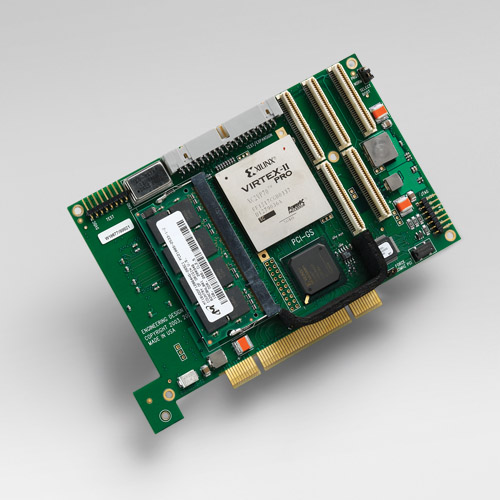Xilinx Virtex 4 SX | L-band and IF receiver
The SRXL2 is a mezzanine board that pairs with an EDT main board to receive and process the following inputs:
- L-band inputs of 900 to 2250 MHz
- IF inputs of 160, 140, 70, or 21.4 MHz
- IF inputs below 90 MHz with a direct sampling path
- Any of the above L-band and IF inputs simultaneously
The user-programmable Xilinx Virtex 4 XC4VSX55 FPGA can perform signal processing or serve as a configurable switch matrix to route data to four digital down-converter Graychips (GC4016).The board also has a TCXO 10-MHz reference clock which can be set for internal or external use.
The SRXL2 can be ordered with either a PCI GS or PCIe8 LX main board for bus connectivity and additional FPGA resources.
The SRXL2 is similar to the SRXL. The main differences are shown below.
| SRXL | SRXL2 | |
|---|---|---|
| FPGA | Xilinx Spartan 3 | Xilinx Virtex 4 SX |
| Graychips | 2 | 4 or 0 |
| L-band | 925 to 2175 MHz (66 MHz bandwidth); 5 MHz tuning resolution | 900-2250 MHz (115 MHz bandwidth); 500 kHz tuning resolution |
| IF
|
65 to 225 MHz (46 MHz bandwidth); 1 MHz tuning resolution | 160 or 140 MHz (70 MHz bandwidth), 70 MHz (40 MHz bandwidth), or other frequencies below 90 MHz with a direct sampling path |
| Sample clock | Programmable to any frequency from 1 to 65 MHz | Programmable to any frequency from 10 to 250 MHz |
| Time code input
|
None | 1 pps, IRIG-B, or other other inputs, with user-configurable output |
| Main board
|
PCIe8 LX, PCI GS, or (legacy) PCI SS (legacy) | PCI GS or PCIe8 LX |



